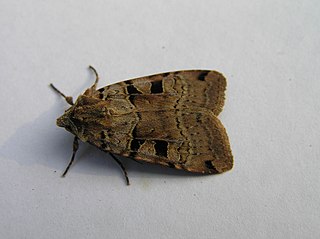
The double square-spot is a moth of the family Noctuidae. It is distributed through most of Europe except Portugal, the Mediterranean islands and northernmost Fennoscandia. In the East, the species ranges East across the Palearctic to Siberia and in the South-East to the Black Sea and in Iran. It rises to a height of about 2,000 metres (6,600 ft) in the Alps.

Apamea crenata, known as the clouded-bordered brindle, is a moth in the family Noctuidae. It is distributed throughout the Palearctic realm. In the North it crosses the Arctic Circle, in the Mediterranean it is found only in cool locations and mountains avoiding very hot areas. In the Alps, it rises to an altitude of about 2000 metres.
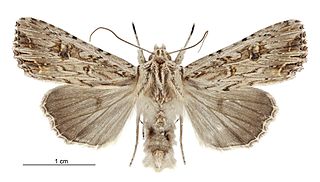
Ichneutica lignana is a moth of the family Noctuidae. It is endemic to New Zealand. This species is found on the Three Kings Islands as well as the North, South and Stewart Islands. This species lives in a variety of habitats including coastal areas, tussock grasslands, shrublands, and native forest, at a range of altitudes from sea level to over 1300 m. I. lignana is quite distinctive in appearance with its dark markings on the abdomen and forewings although it is possible to confuse Ichneutica morosa, Meterana pansicolor and Meterana pascoi with this species. Adults are on the wing throughout the year in the northern parts of the New Zealand but are restricted to the months of October to April in the more southern parts of the country.

Aseptis fumosa is a moth of the family Noctuidae first described by Augustus Radcliffe Grote in 1879. It is widespread in western North America and is known from western Canada, Washington, Nebraska, Colorado, Utah, Arizona, Nevada and California. It occurs in a variety of diverse habitats including coast chaparral, dry conifer forest, and shrub steppe.
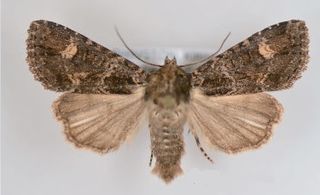
Aseptis binotata, the rusty shoulder knot moth, is a moth of the family Noctuidae. The species was first described by Francis Walker in 1865. It is found widespread in western North America, west of south-central Alberta, Wyoming, and Nebraska. Along the Pacific Coast it occurs from northern Mexico to south-central British Columbia. It can be found from sea level to altitudes over 2000 meters in a variety of habitats from dense forest to shrub desert.

Paraseptis is a monotypic moth genus in the family Noctuidae erected by Tomas Mustelin and Lars G. Crabo in 2015. Its only species, Paraseptis adnixa, was first described by Augustus Radcliffe Grote in 1880. It is widely distributed along the Pacific Coast from northern Mexico to south-western British Columbia in a variety of forested habitats.
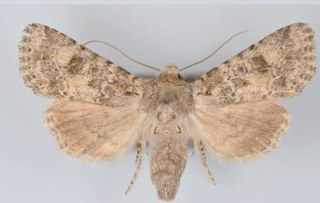
Aseptis catalina is a moth of the family Noctuidae first described by John Bernhardt Smith in 1899. It is found in the deserts of Arizona, California and Baja California in Mexico.

Aseptis ethnica is a moth of the family Noctuidae first described by John Bernhardt Smith in 1899. It is found in North America in Arizona, California, western Oregon, and Baja California Norte in Mexico. The habitat consists of open pine and oak forest and mountain chaparral, mostly at elevations of above 1500 meters in southern California but at lower elevations farther north.

Aseptis characta is a moth of the family Noctuidae first described by Augustus Radcliffe Grote in 1880. It is widespread in western North America, where it is found in the western Great Plains, Great Basin, and Pacific regions from British Columbia, Alberta, and Saskatchewan to Colorado, Utah, northern Arizona and southern California. The species occurs in dry habitats like sagebrush steppe, juniper woodlands, and open forest from sea level to 2,500 meters.

Aseptis fumeola is a moth of the family Noctuidae first described by George Hampson in 1908. It is found in the US state of Arizona, southern and central California, southern Nevada and south-eastern Utah. The habitat consists of foothills and mountains in dry chaparral, parkland, and conifer forest.
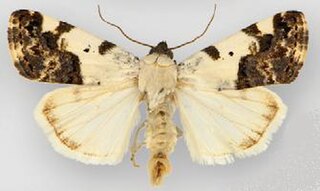
Tarache aprica, the exposed bird dropping moth, is a moth of the family Noctuidae. The species was first described by Jacob Hübner in 1808. It is found in North America from Ontario and Quebec to Florida, west to Arizona, north to Kansas and Iowa. There are some records from Great Britain, but this probably relates to imports.

Aseptis murina is a moth of the family Noctuidae first described by Tomas Mustelin in 2000. It is found in the US in southern California, where it occurs in coastal chaparral, foothills, mountain brush land and oak forest, and in the mountain-desert transition zone from sea level to 2000 meters.

Aseptis ferruginea is a moth of the family Noctuidae first described by Tomas Mustelin in 2000. It is endemic to southern California. All records are from San Diego County, from an area between Boulevard-Manzanita near the Mexican border north to Lake Henshaw at altitudes of 800–1600 meters. The habitat consist of open oak forest, foothill chaparral, and in the mountain-desert transition zone.

Aseptis fanatica is a moth of the family Noctuidae first described by Tomas Mustelin in 2006. It is found in western North America in Washington, Oregon, California, and Baja California Norte in Mexico. It is found in habitats like brush land and open forest in southern California, mostly at 1000–2000 meters, but occurs at lower elevations farther north.

Aseptis lichena is a moth of the family Noctuidae first described by William Barnes and James Halliday McDunnough in 1912. It is found in the United States in south-central California and north-central California. It is also reported from Mount Shasta, Mount Lassen, and other locations in northern California.
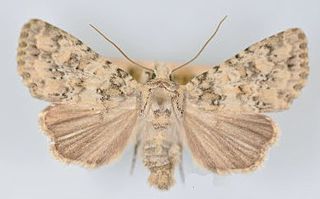
Aseptis pseudolichena is a moth of the family Noctuidae first described by Tomas Mustelin and Ronald Henley Leuschner in 2000. It is endemic to southern California, with records from San Diego, Riverside, Los Angeles, Ventura, San Bernardino, and Tuolumne counties. The habitat consists of open pine and oak forest, open areas with grass and scrub, and foothill chaparral.

Aseptis serrula is a moth of the family Noctuidae first described by William Barnes and James Halliday McDunnough in 1918. It is found in the lower mountain-desert transition zone and in high desert such as the Mojave, Colorado, and Sonora deserts of south-eastern California, Nevada, Arizona and Baja California.
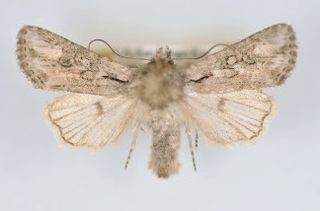
Aseptis torreyana is a moth of the family Noctuidae first described by Tomas Mustelin in 2006. It is found in along the south side of the sea level salt marsh estuary of the Torrey Pines State Reserve in southern California. The habitat is most likely salt marsh, although it could be coastal chaparral.
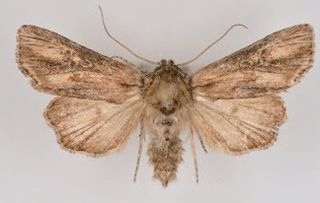
Aseptis susquesa is a moth of the family Noctuidae first described by John Bernhardt Smith in 1908. It is found in Arizona, California and Baja California in Mexico, at least as far south as Ensenada. The habitat consists of rocky areas in the mountain-desert transition zone and high desert.
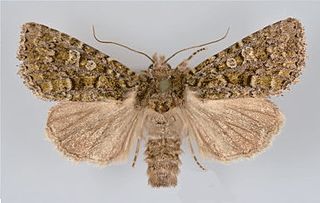
Viridiseptis is a monotypic moth genus in the family Noctuidae erected by Tomas Mustelin and Lars G. Crabo in 2015. Its only species, Viridiseptis marina, was first described by Augustus Radcliffe Grote in 1874. It is found throughout coastal California and in south-western Oregon as far north as Douglas County. It is widely distributed in southern California. It is found in many habitats such as coastal chaparral, mountain forest, mountain-desert transition zone, and occasionally in the deserts from sea level to at least 2000 meters.





















